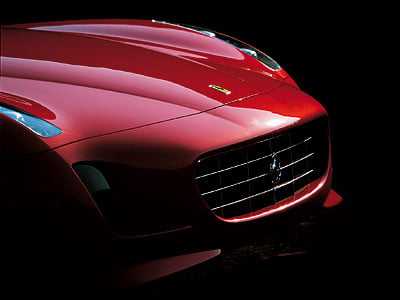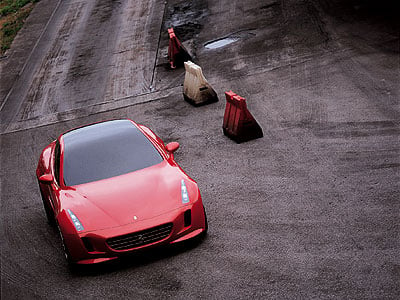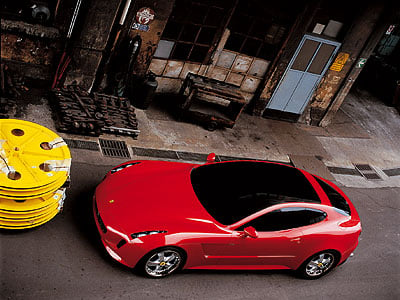The Idea
Text: Jan Baedeker
Photos: Giugiaro
Happy Birthday to me! Giorgetto Giugiaro, the Old Master of Italian styling is presenting a special Ferrari at the Tokyo Motor Show to mark his 50 years of activity in the world of car design. Based on a 612 Scaglietti, the car is a generous touring model with a hatchback, folding rear seats giving greater luggage space - and of course a Ferrari 5,748 cc V12 driving the rear wheels.

The idea to design a very personal Ferrari to celebrate this important anniversary came to Giugiaro for the first time at the Paris Motor Show in 2004 when he had discussions with President and CEO of Ferrari, Luca di Montezemolo. From that moment it was decided to use the 612 Scaglietti as the basis for the concept, and Giugiaro received full technical blessing from Ferrari - as long as the design would be recognisable as a genuine Ferrari. He started work immediately on 1:10 scale sketches - as he did 50 years earlier - that were turned into 1:1 reality by his son Fabrizio, using the Italdesign-Giugiaro Virtual Reality Design Center to produce a full-scale plaster model in April this year. By June a rolling prototype had been made.
In its powerplant and running gear - 5.7 litre V12, 540 HP, rear transaxle with 6-speed sequential change - the Ferrari GG50 is similar to its production counterpart, the focus has rather been on styling and use of space in the interior.

The Design
"In a bird’s-eye view, all cars look like a rectangle", explains Giugiaro. "As a consequence, the dimensions are perceived optically as being the same as the maximum length". In the GG50 however, Giugiaro has rounded to an extreme the curve between the headlamp cowl and the front wheelarch, applying the same treatment to the rear. “When viewed three-quarterwise, this also enhances the look of the car optically, making the car appear leaner and bolder. In a nutshell, rather than having a fender lip that clearly defines the bodyside edge, a seamless line flows toward the centrepoint where the two extremities meet". The car is some 2 cms shorter at the front, and 7 cms at the back compared to the 612.

At the front, the prominent low-slung Ferrari grille is oval in shape and is flanked by two vertical cooling intakes that also house driving lamps. The headlamps themselves are thin vertically-drawn xenon units that flank the tip of the long bonnet that itself has a v-shaped cross profile. The tail is simple with the lower section, housing the chrome dual exhausts, painted black to reduce the overall sensation of height. Incorporating LED technology, the round dual lamps are asymmetric with the vital chrome Prancing Horse in the centre.
In order to accommodate the extra luggage-area of the car (an extras 30 litres over standard, rising to 500 litres, and 1.40 metre-long load capacity, with the back folded down) the car has had its fuel tank moved from behind the rear seats to below the load area. This necessitated a redesign of the rear cross-member, and the addition of the a glass hatchback bootlid has resulted in a strengthened roofline with two reinforced points to take the hinges.

The Interior
In contrast to the overall exterior design of the GG50 that was created by Giorgetto Giugiaro on the drawing board, the interior was developed as the design progressed at an early stage. Giugiaro and his son Fabrizio decided to reduce the ‘closed-in’ feeling for rear-seat passengers by sloping the rear window at the side. This has the effect of making entry to the car a lot easier, through the standard sized 612 Scaglietti’s doors.

More innovations internally include the re-arrangement of switchgear and instruments to utilise the space gained by the (now common, due to the F1 paddle-actuated gearbox)) deletion of a gear lever in the central console, thus freeing up space for the light switches and electronic handbrake. The rest of the instrumentation is standard 612 Scaglietti, however the dashboard is new and includes a AVIC - X1R Pioneer satellite navigator, fitted right in the centre.
The door panels, feature a large glovebox, and have a horizontal natural beech insert, while the seats use the same structural framework of the production car and are covered in beige leather. The upper section of the rear seatbacks can be folded down, thereby creating a flat loading platform at the same height as the new fuel tank.

The Facts
| Motor: | Twelve-cylinder V, 5,748 cc |
| Max. Power: | 540 PS at 7,250 rpm |
| Max. Torque: | 589 Nm at 5,250 rpm |
| Transmission: | 6-speed sequential, rear-mounted in situ with axle and differential |
| Brakes: | Brembo |
| Wheelbase: | 2950 mm |
| Length: | 4810 mm |
| Width: | 1950 mm |
| Height: | 1347 mm |
| Wheels/tyres: | ATP Tecnoforming 20" wheels. Bridgestone tyres, 245/35 ZR20 front, 305/35 ZR20 rear |








